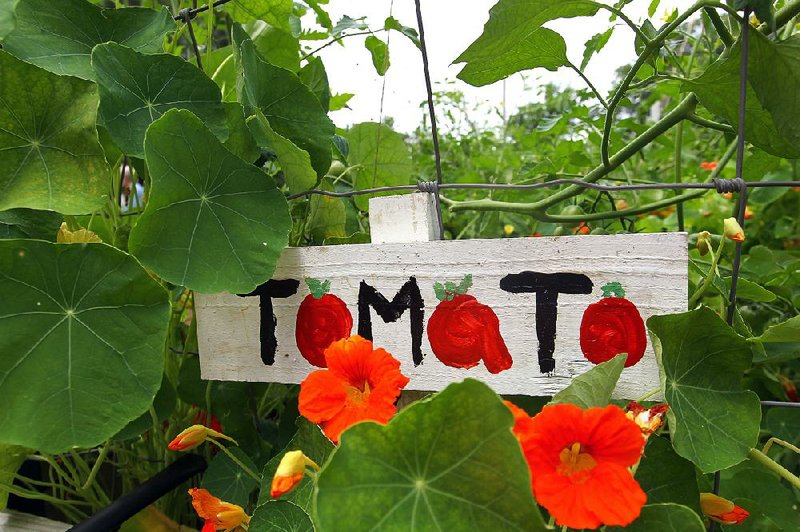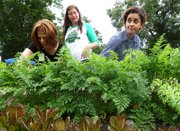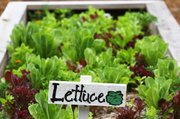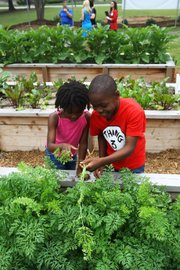Arkansas Children's Hospital is raising lettuce, carrots, spinach and high expectations on a 4,000-square-foot plot on a far corner of the hospital campus in Little Rock.
The hospital spans 36 blocks near Central High School, and "we try to be a good neighbor," community outreach director Scott Allen says.
With the idea of a garden to show the benefits of healthy food and outdoor activity, it seemed only neighborly to "try going door-to-door to let people know what we were doing," he says. The notion took off like a cucumber vine, producing a one-of-a-kind collaboration of medical, government and volunteer partners.
Dedicated in June, the leafy garden represents about a year's work to date. The National Park Service built the 10 raised beds, producing also beets, onions, radishes and snap peas for distribution through Helping Hand of Greater Little Rock. The food pantry supplies families that otherwise might not have fresh produce, an essential source of vitamins, nutrients and fiber.
The garden is meant to raise not only nourishing vegetables but also "plant happiness and friendship that will nourish our souls," park service Ranger Fabian Ruiz said at the dedication. He enlisted the maintenance department from the Central High School National Historic Site to help make the garden.
"The clients we serve in central Arkansas have limited income," Helping Hand director Gayle Priddy said. "They don't have extra dollars to spend on fresh produce."
The garden is color-speckled with bug-deterring marigolds and nasturtiums. And Allen points with pride to the hose-connected sink for washing produce that is unlike anything the garden store sells.
He had put in for any old sink the hospital maintenance crew intended to replace, picturing something kitchen-size. He got a stretch of sink with multiple bays for cleaning medical instruments. But it works for cabbage, too.
"We don't know what this garden is going to become," he says, eyeing more vacant land to the east that could as well be given over to beans. But it's already "a great collaboration." The garden is supported also by the Arkansas Children's Research Institute's Childhood Obesity Prevention Program and by the University of Arkansas for Medical Sciences.
Besides vegetables, the garden provides a way to "further examine how access to fresh produce and physical activity reduce childhood obesity," according to Judith M̶i̶l̶l̶e̶r̶ Weber*, director of the research program.
Arkansas GardenCorps members Acadia Roher and Jimmy Parks tend the garden along with several other projects they look after in the program, which supports urban and community gardening. They have a basket of carrots to show for the effort.
"Here's a pretty good-looking carrot," Parks says from under his wide-brimmed hat, while pulling more. "You oughta try it."
DOWN TO EARTH
Arkansas Children's Hospital describes its vegetable garden as "innovative." It might not have broken entirely new ground, but few other hospitals grow watermelons.
Landscaping, yes, that's different -- and gardens of flowers and greenery to walk through, or just sit for a moment's tranquility as at Winter Haven Hospital in Florida, thanks to the Gardenia Garden Club.
Some hospitals, in fact, feature gardens praised as "breathtaking" by the Accrediting Commission on Education for Health Services Administration. Among them:
curving paths and arbors at Emanuel Children's Hospital in Portland, and the indoor bamboo grove at Ann and Robert H. Lurie Children's Hospital in Chicago.
"Throughout antiquity, societies cultivated gardens in part to stimulate and maintain good health," according to an article posted by the health care accrediting agency.
Today's hospital gardens are backed by modern science that agrees, people often feel better for having spent some time in the garden.
Just three to five minutes of gazing at a garden view of trees and flowers and water can reduce anxiety and even lessen pain, Scientific American reports. "Back in style," gardens figure into the design of most new hospitals, the report goes on.
"One of the fastest growing trends," according to Becker's Hospital Review, "is the installation of green roof, or roof gardens -- some for the view, some for outdoor therapy, and some for down-and-dig vegetable gardening.
Nationally, more than 450 hospitals and food service management companies have pledged to serve healthier meals one way or another, including gardens and farmers markets, according to Health Care Without Harm, a coalition of health care interests.
But not every hospital can dig up a vegetable patch. To have a hospital garden calls for administrative approval just to get started, and the maintenance department might have to give it a work-gloved thumbs-up, besides.
Location is extra important for a hospital, according to the National Recreation and Parks Association. One thing a hospital garden needs to be is "highly visible."
Whatever peace, whatever good things to eat the garden might provide, the larger idea is that it also symbolizes a commitment to healthy living.
SEED IT, DONE IT
People can see the Arkansas Children's Hospital Garden just by driving by the corner of 12th and Schiller streets. On dedication day, nobody could have missed volunteer Betty Harlston's bright pink dress.
"I usually come on Tuesdays and work from 3 to 6," the garden's regular volunteer hours, she says. (Other times, the gates are closed.)
"Families are welcome to bring their children to volunteer during the open hours," according to the hospital's call for helpers. "Volunteer contributions will be vital to providing the produce [that] food-insecure families will receive."
Food insecurity means not knowing where the next meal is going to come from, a condition that Children's Hospital rates as a priority problem. The hospital and its clinics provide free lunches to children year-round.
Helping Hand of Greater Little Rock reports serving more than 15,000 families in 2015. Arkansas is among the nation's most food-insecure states, according to the Arkansas Hunger Relief Alliance.
Against such a need, one garden on the corner might not seem to matter. But it does to Helping Hand director Priddy, who already sees the effort making a positive difference.
"We're not getting a whole lot from the garden yet," she says. But the crops are coming on, and "we appreciate everything we get."
Helping Hand serves as many as 100 families a day, Priddy says. The need keeps her always on the search for fresh produce to give out. Sources include grocery store donations of produce near the end of its shelf life. And, once, a man called about excess tomatoes from his own garden, she says, "and he brought those to us."
One garden can't meet the agency's entire need, she says, but it can help, and it can bring up something at least as important as radicchio -- awareness of hunger relief.
Meantime, any given Tuesday, volunteer Harlston expects to find a half dozen of her friends from the Central High Neighborhood Association at work amid the spinach and squash.
"We get to play in the dirt," she says, "and we don't get scolded."
They plant. And they pull weeds, because that's how it is with weeds.
Weeds are volunteers, too.
DIG IN
For more about Arkansas Children's Hospital, see archildrens.org or call (501) 364-1100. More information about Helping Hand of Little Rock is at lrhelpinghand.com, and (501) 372-4388.
ActiveStyle on 07/11/2016
*CORRECTION: Judith Weber is director of the Arkansas Children’s Hospital’s Research Institute’s Childhood Obesity Prevention Research Program. Her last name was incorrect in this story.




